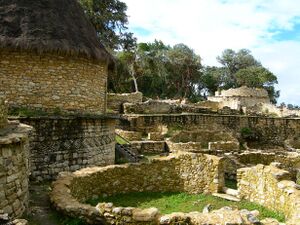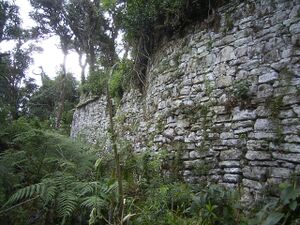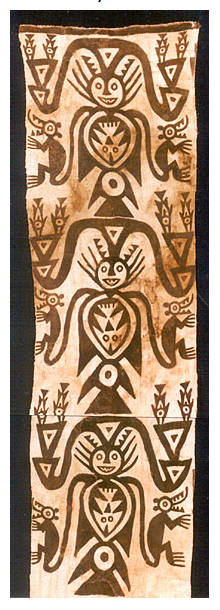ثقافة تشاتشاپويا
 Map of the Chachapoya culture | |
| النطاق الجغرافي | Amazonas, Peru |
|---|---|
| الفترة | Late Intermediate |
| التواريخ | ح. 900 - 1470 |
| سبقها | Wari |
| تلاها | |

The Chachapoyas, also called the "Warriors of the Clouds", was a culture of the Andes living in the cloud forests of the southern part of the Department of Amazonas of present-day Peru. The Inca Empire conquered their civilization shortly before the Spanish conquest in the 16th century. At the time of the arrival of the conquistadors, the Chachapoyas were one of the many nations ruled by the Incas, although their incorporation had been difficult due to their constant resistance to Inca troops.
Since the Incas and conquistadors were the principal sources of information on the Chachapoyas, there is little first-hand or contrasting knowledge of the Chachapoyas. Writings by the major chroniclers of the time, such as Inca Garcilaso de la Vega, were based on fragmentary second-hand accounts. Much of what we do know about the Chachapoyas culture is based on archaeological evidence from ruins, pottery, tombs, and other artifacts. Spanish chronicler Pedro Cieza de León noted that, after their annexation to the Inca Empire, they adopted customs imposed by the Cusco-based Inca. By the 18th century, the Chachapoyas had been devastated; however, they remain a distinct strain within the indigenous peoples of modern Peru.
. . . . . . . . . . . . . . . . . . . . . . . . . . . . . . . . . . . . . . . . . . . . . . . . . . . . . . . . . . . . . . . . . . . . . . . . . . . . . . . . . . . . . . . . . . . . . . . . . . . . . . . . . . . . . . . . . . . . . . . . . . . . . . . . . . . . . . . . . . . . . . . . . . . . . . . . . . . . . . . . . . . . . . . .
Appearance and origins
Cieza de León remarked that, among the indigenous Peruvians, the Chachapoyas were unusually fair-skinned and famously beautiful:
They are the whitest and most handsome of all the people that I have seen in Indies, and their wives were so beautiful that because of their gentleness, many of them deserved to be the Incas' wives and to also be taken to the Sun Temple (...) The women and their husbands always dressed in woolen clothes and in their heads they wear their llautos, which are a sign they wear to be known everywhere.[بحاجة لمصدر]
— "The Incas", Pedro de Cieza de Leon, Chapter 27
However, there is no other account at the time from other travelers to the region that mentions the particular "whiteness'' of the Natives in Chachapoya. These comments have led to claims, not supported by Cieza de León's chronicle, that the Chachapoyas were blond-haired and European in appearance. The chronicle's use of the term "white" here predates its emergence as a racial classification. Another Spanish author, Pedro Pizarro, described all indigenous Peruvians as "white." Although some authors have quoted Pizarro saying that Chachapoyas were blond, these authors do not quote him directly; instead they quote remarks attributed to him and others by race scientist Jacques de Mahieu in support of his thesis that Vikings had brought civilization to the Americas.[2][3] Following up on these claims, anthropologist Inge Schjellerup examined the remains of Chachapoyans and found them consistent with other ancient Peruvians. She found, for example, a universal occurrence of shovel-shaped upper incisors and a near-complete absence of the cusp of Carabelli on upper molars — characteristics consistent with other indigneous peoples and inconsistent with Europeans.[4]

According to the analysis of the Chachapoyas objects made by the Antisuyo expeditions of the Instituto de Arqueología Amazónica, the Chachapoyas do not exhibit Amazon cultural tradition but one more closely resembling an Andean one. Given that the terrain facilitates peripatric speciation, as evidenced by the high biodiversity of the Andean region, the physical attributes of the Chachapoyas are most likely reflecting founder effects, assortative mating, and/or related phenomena in an initially small population sharing a relatively recent common ancestor with other indigenous groups.
The anthropomorphous sarcophagi resemble imitations of funeral bundles provided with wooden masks typical of the "Middle Horizon", a dominant culture on the coast and highlands, also known as the Tiwanaku–Wari culture. The "mausoleums" may be modified forms of the chullpa or pucullo, elements of funeral architecture observed throughout the Andes, especially in the Tiwanaku and Wari cultures.
Population expansion into the Amazonian Andes seems to have been driven by the desire to expand agrarian land, as evidenced by extensive terracing throughout the region. The agricultural environments of both the Andes and the coastal region, characterized by its extensive desert areas and limited soil suitable for farming, became insufficient for sustaining a population like the ancestral Peruvians, which had grown for 3000 years.
This theory has been described as "mountainization of the rain forest" for both geographical and cultural reasons: first, after the fall of the tropical forests, the scenery of the Amazonian Andes changed to resemble the barren mountains of the Andes; second, the people who settled there brought their Andean culture with them. This phenomenon, which still occurs today, was repeated in the southern Amazonian Andes during the Inca Empire, which projected into the mountainous zone of Vilcabamba, raising examples of Inca architecture such as Machu Picchu.
Characteristics
The architectural model of the Chachapoyas is characterized by circular stone constructions as well as raised platforms constructed on slopes. Their walls were sometimes decorated with symbolic figures. Some structures such as the monumental fortress of Kuelap and the ruins of Cerro Olán are prime examples of this architectural style.
Chachapoyan constructions may date to the 9th or 10th century; this architectural tradition still thrived at the time of the Spanish conquest of the Inca Empire until the latter part of the 16th century. To be sure, the Incas introduced their own style after conquering the Chachapoyas, such as in the case of the ruins of Quchapampa in Leimebamba District.
The presence of two funeral patterns is also typical of the Chachapoyas culture. One is represented by sarcophagi, placed vertically and located in caves that were excavated at the highest point of precipices. The other funeral pattern was groups of mausoleums constructed like tiny houses located in caves worked into cliffs.
Chachapoyan handmade ceramics did not reach the technological level of the Moche or Nazca cultures. Their small pitchers are frequently decorated by cordoned motifs. As for textile art, clothes were generally colored in red. A monumental textile from the precincts of Gran Pajatén had been painted with figures of birds. The Chachapoyas also used to paint their walls, as an extant sample in the tunnels of San Antonio in Luya Province reveals. These walls represent stages of a ritual dance of couples holding hands.
The Chachapoyan culture indicated an egalitarian non-hierarchical society through a lack of archaeological evidence and a lack of power expressing architecture that would be expected for societal leaders such as royalty or aristocracy.[5]
See also
- Amazonas before the Inca Empire
- Extinct languages of the Marañón River basin#Chacha
- Machu Pirqa
- Purum Llaqta, Cheto
References
- ^ Cieza de Léon, Pedro (1959). The Incas of Pedro de Cieza de Léon. University of Oklahoma Press: Norman.
- ^ Ibarra Grasso, Dick Edgar (1997) Los Hombres Barbados en la América Precolombina p. 66
- ^ Llanos, Oscar Olmedo (2006) Paranoia Aimara p. 182
- ^ Schjellerup, Inge (1997) Incas and Spaniards in the Conquest of the Chachapoya
- ^ Dr Jago Cooper (Presenter) (2013). Lost Kingdoms of South America - People of the Clouds (video) (in الإنجليزية). Peru: BBC. Event occurs at 39 minutes.
External links
- Ethnography and Archaeology of Chachapoyas
- Chachapoyas: Cultural Development at a Cloud Forest Crossroads
- Tomb Raiders of El Dorado: Archaeological conservation dilemmas in Chachapoyas
- Peru North map including Chachapoyas
- The Second Part of the Chronicle of Peru by Pedro de Cieza de Leon

